Polish intelligence facility "B. 18 "operating in Ukraine reported on June 2, 1933:" People who are emaciated and emaciated. Children look the worst. Death by starvation is a common occurrence. Cannibalism - on the agenda ”. The Bolshevik "paradise" turned out to be the truest hell in which mankind became just another species of white meat.
A few months after the end of World War I, the US Congress established the American Relief Administration. It was an organization dedicated to delivering humanitarian aid to Europe. When a famine struck Bolshevik Russia at that time and Moscow asked for support, the Americans directed a stream of support there.
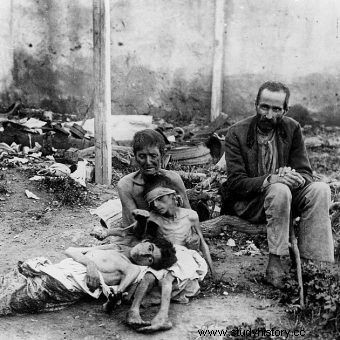
A family dying of exhaustion during the famine in the early 1920s (photo:public domain)
In the late summer of 1921, a group of ARA workers arrived in Samara with humanitarian aid. On the spot, they quickly realized that the famine had become so catastrophic that it was impossible to control it in practice. They immediately reported to Moscow on the matter, which, however, did not bring any reaction from the Russian authorities. Meanwhile, the population was desperate.
Corpse and Cannibals
Little was known in Europe about the true scale of the humanitarian catastrophe. The Russians themselves, living in an atmosphere of increasing red terror, knew even less. Dr. I.A. The treble mentioned by Bertrand M. Patenaude in his book "The Big Show in Bololand" calculated that there were thousands of cases of devouring people.
In Samara itself (where it happened that butcheries were closed for selling human meat!), He managed to document 260, of which 200 were deaths and 60 cannibals. Where does the distinction come from? Well, human flesh could be obtained in two ways - either by feeding on corpses or by killing a human just to eat it.
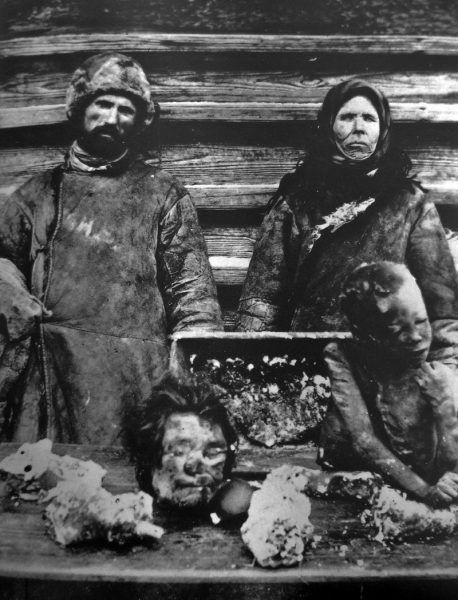
Russians selling human meat during the famine of 1921. (photo:public domain)
Another scientist cited by Bertrand M. Patenaude, Dr. L.M. Wasilewski, also documented cases of cannibalism. At the same time, he attempted to reflect deeper. He compared the then prevailing famine with others known from close history. It turned out that the one from the beginning of the 1920s was one of the largest so far. In addition, he noted that it occurred after the civil war. Any such conflict leads to the depreciation of human life and human dignity. The combination of these factors, he believes, has led to acts of cannibalism on an unprecedented scale.
Could there be anything romantic about cannibalism
Due to starvation, human minds began to hallucinate and dull. The bodies were hit by hunger and the last of their strength was escaping from them. Many people lost their minds, as evidenced by eating, for example, the intestines instead of human flesh, or cutting off the head from the corpse and cooking it. People devoured not only strangers but also their loved ones. Alexis Babine in her diary from Saratov on Valentine's Day 1922 noted a story that is both macabre and ... in a bizarre sense romantic.
Now it was discovered that a woman had begun feeding on her husband's corpse. When the case came to light and the local authorities wanted to take the corpse, my wife went berserk. She screamed that she had no intention of giving it back because it only belonged to her. A few days later, Babine recorded that the Soviet authorities confiscated barrels of salted human flesh every day that different people are trying to bring into town.
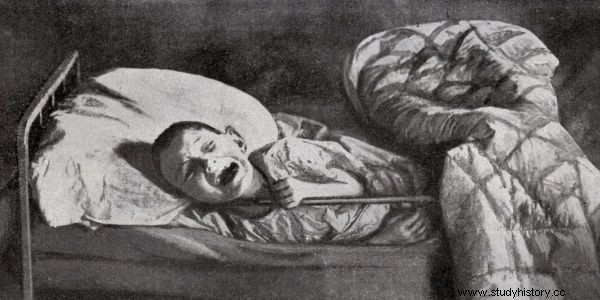
Heavily malnourished boy crying in a hospital bed in Samara (photo:public domain)
ARA operated in Russia until 1923. When it turned out that the money saved by the Soviet authorities was spent on buying weapons abroad instead of saving their citizens, the Americans withdrew. It would seem that this tragic humanitarian defeat should teach the Russian authorities a lesson in humility, which in the future will allow them to better control the situation and protect themselves against a similar tragedy. Nothing could be more wrong.
A fertile field that will not feed anyone
Almost a decade later, the catastrophic famine reigned again throughout the USSR, taking on truly crushing proportions in Ukraine. It was not a consequence of a crop failure, but of a criminal policy of the authorities in Moscow. For a long time, the Bolsheviks considered grain an excellent export commodity, thanks to which they could gain hard currency and exert diplomatic pressure (by threatening to suspend deliveries). Every ruble counted.
As Anne Applebaum emphasizes in her new shocking book "Red Hunger" machinery, parts and other goods were needed to meet the five-year plan. The problem was that they were only available for currency. Stalin made a decision that ultimately cost the lives of millions of people - he decided to squeeze the grain out of the country by force and sell it abroad.
The villages had draconian quotas imposed, enforced with all brutality. The peasants were unable to cope with them, and ruthless officials plundered them, in effect, from the last sack of grain. The kolkhozes were also deprived of their entire grain stocks, leaving no reserves for sowing or animal feed, not to mention the food rations of the kolkhoz workers. The population also received livestock, potatoes and vegetables. In short, all available food was seized, leaving nothing behind. In this way, Stalin caused an artificial famine in Ukraine in 1932-1933, which Rafał Lemkin, the creator of the concept of genocide, recognized as a classic example of this crime.
As the following months passed, indescribable things began to happen in Ukraine. People fell into dementia, swelled with hunger, lost their strength, died of exhaustion in the streets, and gravediggers buried them in mass graves. Sometimes moans or pleas were coming from the pits, but usually no one would accept them and filling in was continued. The gravediggers assumed that there was no point in dragging the dying out of the grave. Today they would save him, tomorrow they would have to bury him again because he would be lying on the street again.
"It turned out not to be rumors, but a terrible truth"
Over time, the hunger became so severe that people began to resort to acts of cannibalism, which the authorities in Kiev, Kharkiv and Moscow were well aware of. People suddenly started to lock the door at night, parents warned children to be careful even of people who had known their whole life - anyone could become a spy, thief or ... cannibal.
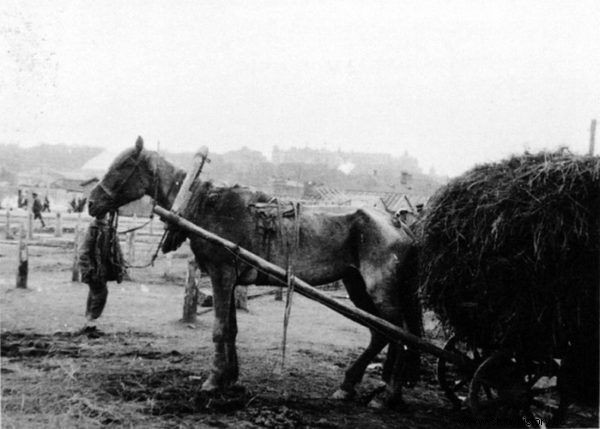
There was no food for people and animals. The photo shows an extremely emaciated horse during the great famine in Ukraine (photo:public domain)
In cities, parents walked their children to the very door of the school, fearing that someone would kidnap them and eat them. Children of apparatchiks, who were better nourished and clothed, were particularly vulnerable. Anne Applebaum, the author of the famous "Gulag", in her new book cites shocking examples when even the closest ones became a mortal threat. Among them is the story mentioned by Łarysa Wenżyk from the Kiev region:
[…] initially there were only rumors, stories that "children disappear somewhere, that degenerate parents eat their children. It turned out not to be rumors, but a terrible truth. Two girls, the daughters of Łarysa's neighbors, from the same street disappeared. Their six-year-old brother Misha ran away from home and wandered around the village, begging and stealing. When asked why he ran away from home, he replied that he was afraid:"my father will cut me."

Photo from the files of the investigation into cannibalism in Kazakhstan. The population was in a dramatic situation not only in Ukraine (photo:public domain)
The militia, informed about the suspicious history, searched the boy's house. Indeed, evidence has been found of a heinous crime committed by parents against their own children. The degenerates were arrested, but Misha was not taken care of. The boy was left to his own devices.
221 cannibals. In one month, in one region
In Sumy, a man went mad with hunger and despair after becoming a widower. At one point, neighbors noticed that his hunger was much smaller than that of others. This aroused suspicion. Eventually, when someone asked how this was possible, the man replied that he had eaten his own children (first a daughter, then a son). The neighbor, who turned out to be too inquisitive, began to threaten that if he talked too much about it, he would eat him too. The man reacted to the cannibal's words with a shout and ran to the police to report what happened.
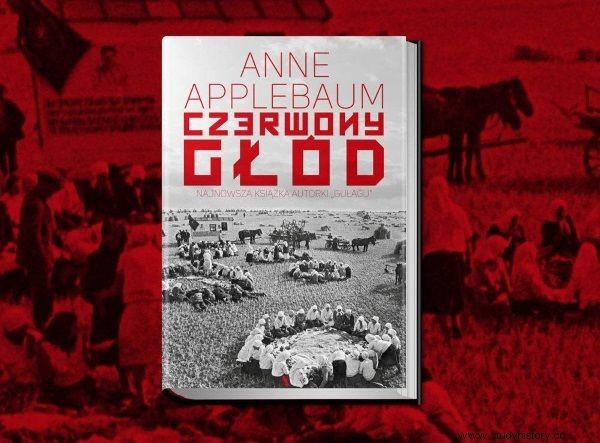
You can buy "Red Hunger" by Anne Applebaum at a discount at the Empik.com bookstore.
With each successive month, the number of similar submissions only grew. In "Red Hunger" we can find figures from the spring of 1933 that are terrifying. These are cases where family members killed the weakest, most often children, and ate their meat. Nine such crimes were reported in Kharkiv Oblast in March, 55 in April, 132 in May, and 221 in June. The figures make it too clear the scale of desperation and beastliness.
The authorities tried to cover up the truth about the hideous practice, but there were too many murders to hide all of them. The head of the OGPU (Soviet intelligence and counterintelligence service) in the Kiev region reported to his superior that in the villages "the view that you can eat human flesh is getting stronger every day. This opinion is common among hungry and swollen children. ”
The tragedy of Leningrad
The next, third wave of acts of cannibalism fell on the USSR almost a decade later. In 1939, Germany and the USSR attacked Poland together. In 1941, it was Hitler who attacked Stalin, launching Operation Barbarossa. The retreating Soviet troops used scorched earth tactics, taking whatever supplies they could grab and destroying what they left behind. For the people who remained in their villages through which the front was swept, this meant more years of famine.
The prospects for civilians were dark - Hitler assumed that the Wehrmacht was to feed itself on the conquered territories and ship the surpluses to the Reich. As for him, the inhabitants of the territories occupied by the Germans might as well starve to death and thus make room for the master race. And unfortunately that was exactly their fate. As Anne Applebaum writes, in the winter of 1941, the Germans cut off food supplies to the cities. In Kiev alone, over 50,000 people died of starvation in these few months. However, the most famous episode of Operation Barbarossa was the siege of Leningrad, which began on September 8, 1941 and lasted two and a half years, killing 1,500,000 lives.
It was almost impossible to deliver food to the city, and when all supplies had been eaten and even the vilest surrogate food was running out, people began to view each other as a meal. In order to save themselves from starvation, the residents of the boarding school at the vocational school, for example, resorted to cannibalism.

Victims of the siege of Leningrad (photo:Boris Kudoyarov, license CC-BY-SA 3.0)
They began to eat their colleagues who had previously died of starvation. When they were caught, they all confessed. Eleven students were arrested. (We wrote more about hunger and cannibalism in Leningrad in our other article.)
Never again?
Although the USSR suffered from crop failures in the following decades, the situation was never so dramatic as in the years of great famines. One would expect that under the new conditions, and certainly with the collapse of the brutal communist regime, the threat of breaking one of the greatest taboos, which is eating human flesh, would also disappear. However, this threat did not go down in history at all. The media in contemporary Russia keeps reporting on newer and newer cases of cannibalism.
The last high-profile case was that of Natalia, born in 1975, and her husband, who was seven years her junior, Dimitriy Bakshheev. When the militia entered their home, terrifying things were found there. Inside were seven bags of human remains. The freezer was filled with human flesh. Photographs of human severed limbs were secured. Officers also found recipes for making exquisite human meat dishes and photographs of these meals. The couple admitted that they had been killing since 1999, killing and eating a total of 30 people. After the psychiatric evaluation it was concluded that Natalia ... is perfectly healthy.
